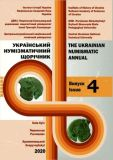ПРО ДАТУВАННЯ БРЯНСЬКИХ ІМІТАЦІЙ ДАНГІВ УЗБЕКА
ABOUT THE DATING OF THE BRYANSK COIN IMITATIONS OF THE ÖZ BEG KHAN’S DANGS
Author(s): Vasiliy V. ZaytsevSubject(s): Archaeology, Economic history, 13th to 14th Centuries, 15th Century
Published by: ДВНЗ Переяслав-Хмельницький державний педагогічний університет імені Григорія Сковороди
Keywords: imitations of the Jochid dangs; Bryansk principality; money circulation; coin hoards; dating of coins;
Summary/Abstract: In the last quarter of the 14th – early 15th century on the territory of many Russian principalities bordering on the possessions of the Golden Horde, silver coins were minted, typologically imitating the Jochid (Juchid) dirhams (dangs). On the base of commonality of typology of the imitative coins several groups of imitations are distinguished, each of which is associated with certain “lands”, principalities, or centers of feudal possessions. The places of minting of imitations belonging to different groups and types can be determined, first of all, on the basis of an analysis of the topography of their finds. The dating of the coinage of various imitations is established due to their presence in hoards of different times, reliably dated by the Golden Horde coins. One of the groups of bifacial imitations of the Golden Horde coins are the so-called Bryansk imitations of dangs of Öz Beg Khan. These are silver coins with an average weight of about 1.2 g, both sides of which are imitation of the Arabic legend (inscription), imitating the type of the reverse side of the dangs of Öz Beg Khan (1313–1341), minted in Sarai in the 30s of the 14th century, with a Creed (symbol of faith). Such imitations were relatively recently singled out into a separate group and got their name due to the concentration of their finds on the territory of the Podesenya in Bryansk (the present Bryansk region of the Russian Federation and adjacent regions). Numismatists still did not have a common opinion on the time of minting of Bryansk imitative coins. The three coin hoards that have become known in recent decades allows us to date these coins. The first of these hoards, which contained one Bryansk imitation, was found in autumn 2010 in the Kaluga region and consisted of Jochid dangs. The time of its hiding, judging by its composition, belongs to the first decade of the 15th century. The second treasure with Bryansk imitations, which is, judging by its small size, a lost or hidden “wallet”, was discovered in 2016 near the village of Lipnitsa, Sevsky district, Bryansk region. The Lipnitsky hoard consisted of 24 coins, including 20 Prague grochens of Wenceslaus IV (1378–1419), three Russian imitations of the Golden Horde dirhams and one Jochid dang. All three imitative coins of the complex belong to the same type and are Bryansk imitations of the Sarai dangs of Öz Beg. Considering that the Prague grochens of Wenceslaus IV were in circulation in the region throughout the entire 15th century, the Jochid dang plays a decisive role in establishing the dating of the Lipnitsky hoard. The coin doesn’t have a date indication. However, this circumstance is compensated by her belonging to the Sarai coinage of Khan Pulad (1407– 1410), who was in power for less than four years. The presence of dang of Pulad in the Lipnitsky monetary complex, therefore, allows us to assert that its formation took place later than the end of the first decade of the 15th century. The third treasure, which contained Bryansk imitations of dangs of Öz Beg, is a small coin complex found in the spring of 2014 in the Starodubsky district of the Bryansk region. This treasure included at least six Jochid dirhams and at least five imitations of them. Among the latter, there were also two Bryansk imitations of the Sarai dangs of Öz Beg Khan. Terminus post quem of the complex is determined by the dang of Shadi Beg Khan (1399–1407), minted in the Horde around 807–809 A.H. (1404−1407). This list of treasures shows that the period of the most frequent presence of Bryansk imitations in the monetary circulation of the region should be considered the first and the beginning of the second decade of the 15th century. This circumstance, considering the absence of such coins in the monetary complexes of the previous century, allows us to confidently attribute the minting of bifacial imitations of the Sarai dangs of Öz Beg Khan with the creed to the end of the 14th – beginning of the 15th centuries. This dating of the Bryansk imitations allows us to presumably link their mintage with the second reign in Bryansk of the Roman Mikhailovich in 1399−1401, who was at the same time the governor of Vytautas in Smolensk.
Journal: Український Нумізматичний Щорічник
- Issue Year: 2020
- Issue No: 4
- Page Range: 104-113
- Page Count: 10
- Language: Russian

